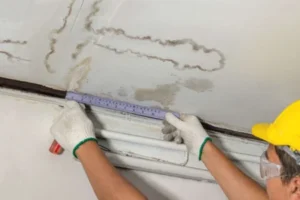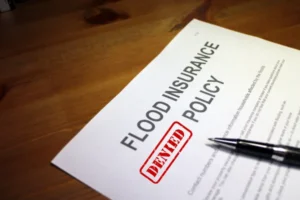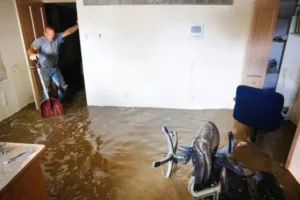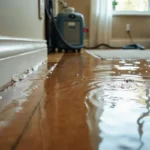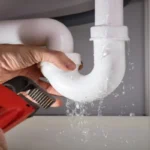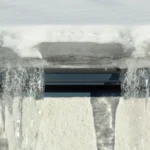Water damage can disrupt your home in an instant, whether it comes from a burst pipe, a leaking appliance, or a sudden basement flood. Beyond the stress of cleanup and repairs, one of the biggest challenges homeowners face is navigating their insurance policies. Filing a water damage insurance claim isn’t always straightforward, and many people discover too late that their policy doesn’t cover the type of damage they’ve experienced.
This guide explains what’s usually covered, what isn’t, and the steps you should take when making a claim. We’ll also look at special cases—like basement flooding—and share practical advice on how to avoid common pitfalls. By the end, you’ll have a clearer understanding of your water damage coverage insurance and how to handle unexpected events more confidently.
What is Covered Under a Water Damage Insurance Claim?
When filing a damage claim, it’s important to know what situations typically qualify for coverage. Home insurance is designed to protect against sudden, accidental events—not gradual wear and tear. That distinction matters when you’re deciding whether to file a claim or not.
Common Types of Water Damage Covered by Insurance
Most policies provide financial protection for incidents that happen suddenly and without warning. These include:
- Burst or frozen pipes that cause water to spread quickly.
- Accidental appliance leaks, such as a washing machine overflowing.
- Heavy rain or roof leaks when water enters the home unexpectedly.
- Mold growth that develops as a direct result of a covered water event.
The key is that the event must be sudden and accidental. If your dishwasher hose breaks overnight, chances are it’s covered. If the hose has been slowly leaking for years, insurers usually categorize that as maintenance neglect rather than an insurable event.
Situations Not Typically Covered by Water Damage Insurance
Just as important as knowing what’s covered is recognizing the exclusions. Many homeowners are surprised when they learn their damage claim is denied for reasons like these:
- Flooding from natural disasters, such as rivers overflowing or heavy storms. Standard policies rarely include flood coverage; it usually requires separate flood insurance.
- Gradual leaks or wear and tear that happen over time, like deteriorated caulking around a tub or an old roof.
- Sewage or drain backups, unless you’ve purchased an additional rider for that risk.
Knowing these situations can help you decide whether you need supplemental coverage to stay fully protected.
How to File a Water Damage Claim with Your Insurance Provider
When water damage strikes, time is critical. Acting quickly not only minimizes further destruction but also sets the foundation for a successful claim. Knowing how to file a home insurance claim for water damage can make the process smoother.
Steps to Take Immediately After Water Damage Occurs
Here’s what to do the moment you discover water damage:
- Stop the source – Turn off the main water valve or power to an appliance if possible.
- Document everything – Take clear photos and videos of all affected areas before moving or cleaning anything.
- Protect your property – Make temporary fixes (like placing buckets under leaks or removing soaked rugs) to prevent further loss.
- Notify your insurer promptly – The sooner you call, the better your chances of a straightforward claims process.
These steps show your insurer that you’ve acted responsibly, which strengthens your case.
Essential Documentation Needed for Your Claim
Insurance companies rely on evidence to validate your claim. Be thorough in what you provide:
- Photos and videos of the damage from multiple angles.
- An inventory of affected belongings, including their estimated value.
- Repair estimates from licensed contractors.
- Correspondence records—keep notes of phone calls and copies of emails with your insurer.
This documentation builds a strong foundation and reduces the chances of disputes later.
What to Do if Your Water Damage Claim is Denied
Even with preparation, not every water damage insurance claim is approved. Sometimes insurers deny coverage, leaving homeowners frustrated and unsure of what to do next.
Understanding Why Claims Are Denied
Denials usually stem from specific reasons written into your policy. Common examples include:
- The damage resulted from a cause excluded in your coverage.
- The claim wasn’t reported promptly.
- Documentation was incomplete or insufficient.
Recognizing why your water damage and insurance claim was rejected can help you take corrective steps and prevent similar issues in the future.
How to Appeal a Denied Water Damage Claim
If you believe your claim should have been approved, you can challenge the decision. Here’s how:
- Review the denial letter carefully and compare it against your policy language.
- Gather stronger evidence—such as additional photos, professional assessments, or repair invoices.
- Draft an appeal letter that clearly outlines why you disagree with the denial.
- Submit your appeal promptly, as insurers often have strict deadlines.
In some cases, it may be beneficial to consult a public adjuster or a legal expert to strengthen your position.
Special Considerations for Basement Flood Insurance Claims
Basements are particularly vulnerable to water damage, and navigating a basement flood insurance claim can feel overwhelming. Standard insurance usually excludes natural flooding, but some coverage may still apply.
What’s Covered in Basement Flood Claims?
Depending on your policy and additional endorsements, coverage may include:
- Structural repairs to foundations, flooring, or drywall.
- Replacement of personal belongings damaged by water.
- Professional cleanup and restoration services.
The extent of coverage depends heavily on whether a natural disaster, plumbing failure, or sewage backup caused the flood. Always confirm the details with your insurer before assuming you’re protected.
Preventing Future Basement Flooding and Insurance Coverage
Prevention not only saves you money but can also make your property more insurable. To reduce the risk of repeat claims:
- Install sump pumps with battery backups.
- Improve drainage systems around your home’s foundation.
- Seal cracks in the basement walls and floors.
- Schedule regular maintenance checks to spot issues early.
Insurers look favorably on proactive homeowners, and taking preventive measures may even reduce your premiums over time.
How to Maximize Your Water Damage Insurance Claim
Once you’ve started the claims process, your next goal is to ensure you receive the compensation you’re entitled to. Maximizing a water damage insurance claim means being proactive, organized, and cooperative.
Key Tips for Ensuring Your Water Damage Claim is Approved
A few strategies can improve your odds:
- Provide detailed evidence and keep everything well-documented.
- Retain receipts for emergency repairs, cleaning supplies, or temporary lodging if you had to relocate.
- Stay in close communication with your insurer to avoid delays.
Consistency and transparency often make the difference between approval and denial.
Working with Insurance Adjusters: What to Expect
Insurance adjusters evaluate your claim and determine the payout amount. Here’s how to approach the process:
- Be available and cooperative—adjusters will visit your home to inspect damage.
- Provide complete documentation and answer their questions honestly.
- Clarify discrepancies if their report undervalues the extent of your losses.
Remember, the adjuster works for the insurance company, not for you. Staying professional but assertive helps ensure you receive a fair settlement.
Final Thoughts on Water Damage Claims
Dealing with water damage is stressful enough without the added confusion of filing an insurance claim. If your claim is denied, don’t lose hope—appeals and additional coverage options may still provide relief. At the end of the day, the best defense against unexpected losses is knowledge.
Need Help Navigating Your Water Damage Insurance Claim? Contact Our Experts Today!


